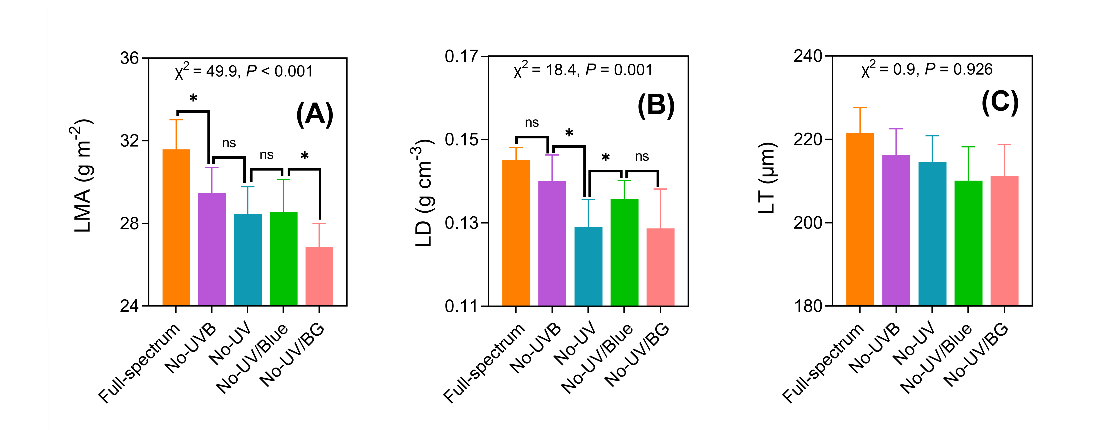Sunlight Drives Leaf Mass Area Depending on Spectral Composition
Plant functional traits generally reflect the trade-off strategy between plant resource acquisition and investment under environmental changes. Plant leaves, as the main organ that converts inorganic carbon into organic carbon. Leaf mass area (the leaf mass per unit area, LMA), the core trait of "Leaf Economics Spectrum" theory, characterizes the morphological, physiological and biochemical functions of the leaves, as well as the functions and processes of the ecosystem. Therefore, a better understanding of the abiotic driving factors of LMA is the key to predict how terrestrial ecosystem functions respond to climate change.
A large number of previous studies have explored the response of LMA and its components to various environmental changes in nature, confirming that light is the dominant factor driving changes in LMA, rather than temperature, moisture, nutrients, and CO2. However, sunlight is composed of spectra in different wavelength bands, which are ignored in previous studies, so far, there is a lack of understanding of the internal mechanisms.
WANG Qingwei from the Institute of Applied Ecology, Chinese Academy of Sciences (CAS), collaborating with a couple of senior ecologists, conducted a spectral attenuation experiment to quantified the relative importance of solar spectral compositions on variation in LMA and its structural, chemical, and physiological components.
One of the key findings is that LMA changes are driven by UV-B radiation (280-315nm) and green light (500-600nm), and the structure is mainly determined by density rather than thickness.
“This finding clarifies the dominant spectrum that drives the changes in LMA, breaking through the traditional cognition that light intensity is the core of the research, broadening the current comprehension,” said Qingwei.
Qingwei and his collaborators also found LMA and density are significantly negatively correlated with lignin, non-structural carbohydrates, and soluble sugars. It indicates that there is a trade-off strategy in the resource allocation between leaf structure and metabolic functions of plants.
“No matter how the light intensity changes, the spectral composition of canopy solar radiation can be adjusted through resource investment and structural support to adjust LMA. Such finding will contribute to understand the adaptation strategies of terrestrial plants to changes in the earth's environment and predict the response of terrestrial ecosystem functions.” said Dr. Hiroko Kurokawa from Forestry and Forest Products Research Institute (FFPRI), Japan.
This study has been published in Physiologia Plantarum entitled “Leaf density and chemical composition explain variation in leaf mass area with spectral composition among 11 widespread forbs in a common garden”.
This research was financially supported by the CAS Young Talents Program, National Natural Science Foundation of China, the Japan Society for the Promotion of Science, etc.

Fig. 1 Variation in (A) leaf mass per area (LMA), (B) leaf density (LD), and (C) leaf thickness (LT) under different spectral irradiance treatments (Image by WANG Qingwei).

Fig. 2 Relationship between (A) leaf mass per area (LMA) with leaf density (LD), (B) LMA with leaf thickness (LT), and between (C) LT with LD across species for each spectral treatment (Image by WANG Qingwei).
Contact
YUE Qian
Institute of Applied Ecology, Chinese Academy of Sciences
Tel: 86-24-83970324
E-mail: yueqian@iae.ac.cn



